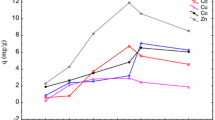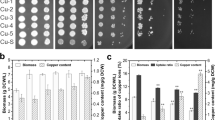Abstract
Yeast cells are capable of accumulation of various heavy metals, preferentially accumulating those of potential toxicity and also those of value. They retain their ability to accumulate heavy metals under a wide range of ambient conditions. In the present study it was shown that yeast cells in suspension accumulate heavy metal cations such as Cu2+, Co2+. The level of copper accumulation was dependent on the ambient metal concentration and was markedly inhibited by extremes of ambient pH. Temperature (5–40°C) and the presence of the alkali metal sodium had much smaller effects on the level of copper accumulation. This suggests that in waste-waters of pH 5.0–9.0, yeast biomass could provide an effective bioaccumlator for removal and/or recovery of the metal. During bioaccumulation and subsequent processes it is necessary to retain the biomass. It was shown in the present study that this could be achieved by cell immobilization. Immobilization allowed for complete removal of Cu2+, Co2+, and Cd2+ from synthetic metal solutions. The immobilized material could be freed of metals by use of the chelating agent ethylenediamine tetraacetic acid (EDTA) and recycled for further bioaccumulation events with little loss of accumulation capacity.
Similar content being viewed by others
References
Brown TA, Smith DG (1977) Cytochemical localization of mercury in Cryptococcus albidus grown in the presence of mercuric chloride. J Gen Microbiol 99:435–439
Chibata I, Tosa T, Sato T (1974) Immobilized aspartase-containing microbial cells: preparation and enzymatic properties. Appl Microbiol 27:878–885
Chibata I, Tosa T, Sato T (1986) Methods of cell immobilization. In: Demain AL, Soloman NA (eds) Manual of industrial microbiology and biotechnology. American Society for Microbiology, Washington, D.C., pp 215–229
Darnall DW, Greene B, Henzl MT, Hosea JM, McPherson RA, Sneddon J, Alexander MD (1986) Selective recovery of gold and other metal ions from an algal biomass. Environ Sci Technol 20:206–208
Friis N, Myers-Keith P (1986) Biosorption of uranium and lead by Streptomyces longwoodensis. Biotechnol bioeng 28:21–28
Gadd GM (1990a) Heavy metal accumulation by bacteria and other microorganisms. Experientia 46:834–840
Gadd GM (1990b) Metal tolerance. In: Edwards C (ed) Microbiology of extreme environments. Open University Press, Milton Keynes, pp 178–210
Good NE, Winget GD, Winter W, Connolly TN, Izwara S, Singh RMM (1966) Hydrogen buffers for biological research. Biochemistry 5:467–477
Greenberg AE, Conners JJ, Jenkins D, Franson MAH (1980) Determination of metals. Standard methods for the examination of water and wastewater, 5th edn. APHA, AWWA, WPCF, pp 139–246
Huang CP, Westman D, Quirk K, Huang JP (1988) The removal of cadmium (II) from dilute aqueous solutions by fungal absorbent. Water Sci Technol 20:369–376
Jones RP, Greenfield PF (1984) A review of yeast ionic nutrition. Part I: growth and fermentation requirements. Process Biochem 19:48–60
Klein J, Vorlop K-D (1985) Immobilization techniques-cells. In: Moo-Young M (ed) Comprehensive biotechnology, vol 2. Pergamon Press, Oxford, pp 203–224
Lewis D, Kiff RJ (1988) The removal of heavy metals from aqueous effluents by immobilized fungal biomass. Environ Technol Lett 9:991–998
Lundgren DG, Volkova-Valchanova M, Reed R (1986) Chemical reactions important in bioleaching and bioaccumulation. Biotechnol Bioeng Symp 16:7–22
Macaskie LE, Dean ACR (1984) Cadmium accumulation by Citrobacter sp. J Gen Microbiol 130:53–62
Murray AD, Kidby DK (1975) Sub-cellular location of mercury in yeast grown in the presence of mercuric chloride. J Gen Microbiol 86:66–74
Nakajima A, Horikoshi T, Sakaguchi T (1982) Recovery of uranium by immobilized microorganisms. Eur J Appl Microbiol Biotechnol 16:88–91
Norberg A, Rydin S (1984) Development of a continuous process for metal accumulation by Zoogloea ramigera. Biotechnol Bioeng 26:265–268
Norris PR, Kelly DP (1977) Accumulation of cadmium and cobalt by Saccharomyces cerevisiae. J Gen Microbiol 99:317–324
Norris PR, Kelly DP (1979) Accumulation of metals by bacteria and yeasts. Dev Ind Microbiol 20:299–308
Rothstein A, Hayes AD (1956) The relationship of the cell surface to metabolism. XIII. The cation-binding properties of the yeast cell surface. Arch Biochem Biophys 63:87–99
Shumate II SE, Strandberg GW, Parrott JR Jr (1978) Biological removal of metal ions from aqueous process streams. Biotechnol Bioeng Symp 8:13–20
Thompson GA, Watling RJ (1987) Bioaccumulation potential of heterotrophic bacteria for lead, selenium, and arsenic. Bull Environ Contam Toxicol 38:1049–1054
Tosa T, Sato T, Mori T, Chibata I (1974) Basic studies for continuous production of l-aspartic acid by immobilized Escherichia coli cells. Appl Microbiol 27:886–889
Author information
Authors and Affiliations
Additional information
Correspondence to: J. R. Duncan
Rights and permissions
About this article
Cite this article
Brady, D., Duncan, J.R. Bioaccumulation of metal cations by Saccharomyces cerevisiae . Appl Microbiol Biotechnol 41, 149–154 (1994). https://doi.org/10.1007/BF00166098
Received:
Revised:
Accepted:
Issue Date:
DOI: https://doi.org/10.1007/BF00166098




